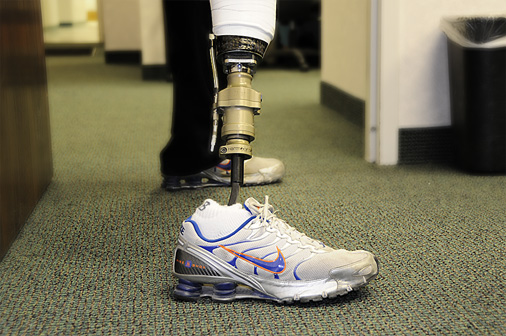
Shoes for Amputees
For amputees, shoe shopping is a challenge, no two ways about it. Poor shoe selection can lead an
amputee to feel unbalanced and can even lead to serious injury. Ideally, an
amputee should bring all shoes to the
prosthetist for evaluation.
Flat Shoes
Many people assume that the flattest shoe is the safest shoe for an
amputee. However, most prosthetic feet are designed to accommodate a small shoe heel height, for example 3/8”. Anything flatter than that and the
amputee will feel as though he or she is being pushed slightly backwards. Additionally, the angle of the prosthetic
socket may be thrown off. In this case, a below the knee
amputee (BKA) may feel more pressure under the knee cap (
patella) when wearing flat shoes. To counter this, the
prosthetist may advise the
amputee to use a small heel wedge in the shoe of the prosthetic side.
High Heels
Many men and women prefer to use high heels on special occasions, whether it’s a pair of cowboy boots or a nice pair of pumps. If the heel is too high, the
amputee will feel that the
prosthesis is thrusting forward. This is particularly dangerous for above the knee amputees (AKA). Many prosthetic knees are weight activated at the toe. When the heel is too high, it can push the
amputee to ride the prosthetic foot toe, which activates the knee to bend involuntarily. That could translate to a nasty fall.
Sandals
Aside from any potential heel height issues with a sandal, the strapping can be a problem. If the strapping on the sandal is too flimsy, the prosthetic foot will not be held securely and could slide around in the shoe. To avoid this
instability, the sandal strapping should be adjustable and thick enough to hold the prosthetic foot securely. The strapping should hold all portions of the foot in place, the toe, the mid foot, the heel, and the ankle.
Dress Shoes
Dress shoes should not only have the appropriate heel height, but the sole of the shoe itself should provide adequate cushioning. The
amputee’s sound
limb experiences increased stress during walking and thin dress shoe soles do not absorb enough shock. In this case, the
amputee may want to use a
shoe insert to cushion and support the sound foot.
Running Shoes
Running shoes, or sneakers, are generally the best option for amputees. Running shoes are held securely, usually possess the appropriate heel height, and provide adequate shock absorption in the sole.
Tips:
• Prosthetic feet are generally measured in centimeters. It’s better to slightly underestimate a foot size than over estimate. In other words, it’s sometimes better to have a prosthetic foot 1 cm short in length. Larger prosthetic feet are more difficult to fit into shoes.
• If not wearing a shoe sock, an amputee can use a shear foot sock (hose material) over the prosthetic foot shell. It will make the shoe glide more easily onto the prosthesis.
• Shoe horns are incredibly helpful
• It is easier to put a shoe on a prosthesis when the amputee is not wearing the prosthesis.
• If wearing pants, an amputee can put the prosthesis in the pant leg first, then apply the shoe, then apply the prosthesis.
• Store workers are more helpful during less busy store hours, like week day mornings.
• Shop online. On www.zappos.com, a shopper can specify shoe type (sandal, dress shoe, etc... ), color, size, and heel height. This website has a great return policy and regularly shipping is free.
• An amputee who loves to change shoes and heel heights may want to consider an adjustable heel prosthetic foot, which can be adjusted easily by the amputee.